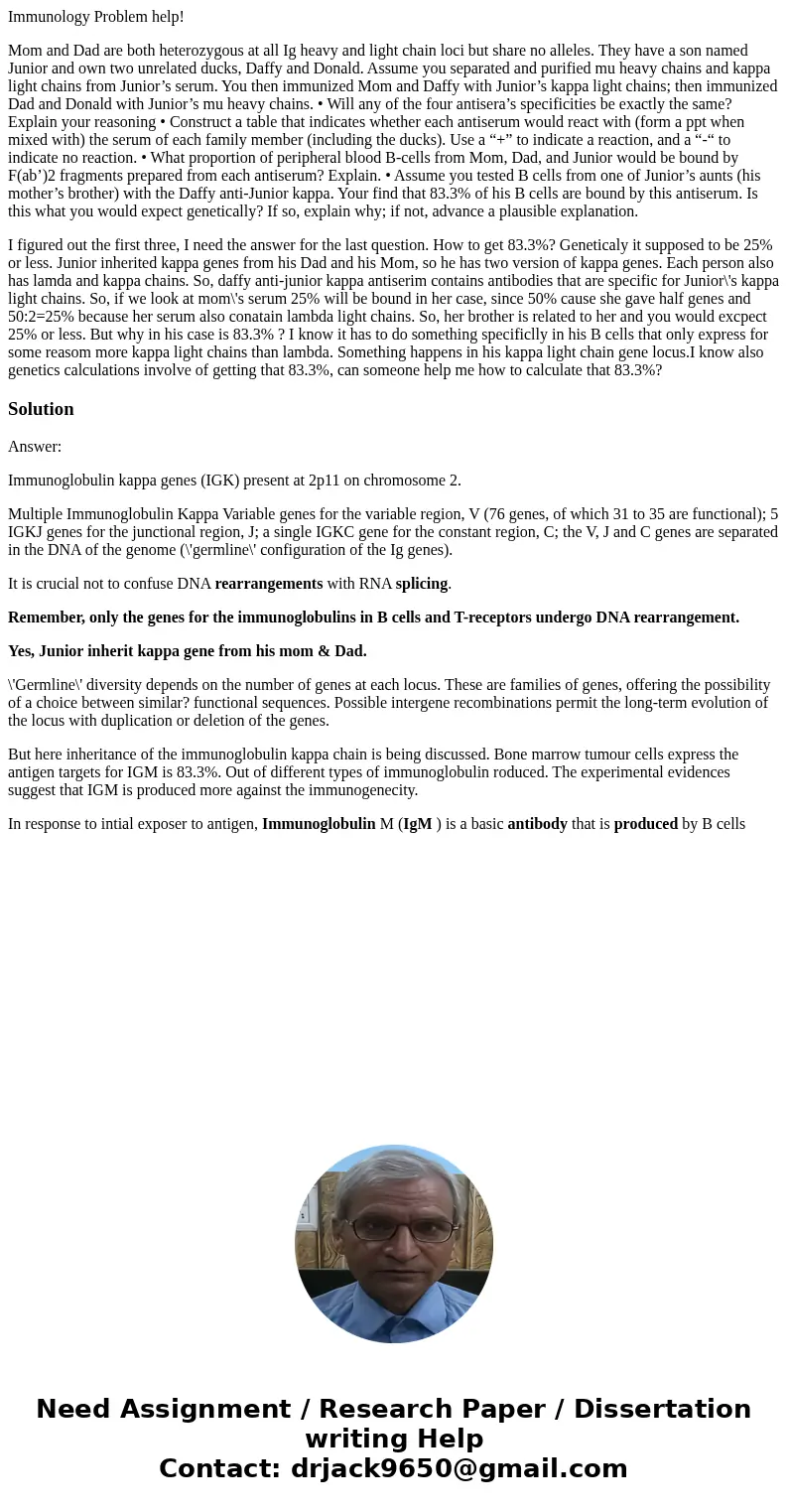Immunology Problem help Mom and Dad are both heterozygous at
Immunology Problem help!
Mom and Dad are both heterozygous at all Ig heavy and light chain loci but share no alleles. They have a son named Junior and own two unrelated ducks, Daffy and Donald. Assume you separated and purified mu heavy chains and kappa light chains from Junior’s serum. You then immunized Mom and Daffy with Junior’s kappa light chains; then immunized Dad and Donald with Junior’s mu heavy chains. • Will any of the four antisera’s specificities be exactly the same? Explain your reasoning • Construct a table that indicates whether each antiserum would react with (form a ppt when mixed with) the serum of each family member (including the ducks). Use a “+” to indicate a reaction, and a “-“ to indicate no reaction. • What proportion of peripheral blood B-cells from Mom, Dad, and Junior would be bound by F(ab’)2 fragments prepared from each antiserum? Explain. • Assume you tested B cells from one of Junior’s aunts (his mother’s brother) with the Daffy anti-Junior kappa. Your find that 83.3% of his B cells are bound by this antiserum. Is this what you would expect genetically? If so, explain why; if not, advance a plausible explanation.
I figured out the first three, I need the answer for the last question. How to get 83.3%? Geneticaly it supposed to be 25% or less. Junior inherited kappa genes from his Dad and his Mom, so he has two version of kappa genes. Each person also has lamda and kappa chains. So, daffy anti-junior kappa antiserim contains antibodies that are specific for Junior\'s kappa light chains. So, if we look at mom\'s serum 25% will be bound in her case, since 50% cause she gave half genes and 50:2=25% because her serum also conatain lambda light chains. So, her brother is related to her and you would excpect 25% or less. But why in his case is 83.3% ? I know it has to do something specificlly in his B cells that only express for some reasom more kappa light chains than lambda. Something happens in his kappa light chain gene locus.I know also genetics calculations involve of getting that 83.3%, can someone help me how to calculate that 83.3%?
Solution
Answer:
Immunoglobulin kappa genes (IGK) present at 2p11 on chromosome 2.
Multiple Immunoglobulin Kappa Variable genes for the variable region, V (76 genes, of which 31 to 35 are functional); 5 IGKJ genes for the junctional region, J; a single IGKC gene for the constant region, C; the V, J and C genes are separated in the DNA of the genome (\'germline\' configuration of the Ig genes).
It is crucial not to confuse DNA rearrangements with RNA splicing.
Remember, only the genes for the immunoglobulins in B cells and T-receptors undergo DNA rearrangement.
Yes, Junior inherit kappa gene from his mom & Dad.
\'Germline\' diversity depends on the number of genes at each locus. These are families of genes, offering the possibility of a choice between similar? functional sequences. Possible intergene recombinations permit the long-term evolution of the locus with duplication or deletion of the genes.
But here inheritance of the immunoglobulin kappa chain is being discussed. Bone marrow tumour cells express the antigen targets for IGM is 83.3%. Out of different types of immunoglobulin roduced. The experimental evidences suggest that IGM is produced more against the immunogenecity.
In response to intial exposer to antigen, Immunoglobulin M (IgM ) is a basic antibody that is produced by B cells

 Homework Sourse
Homework Sourse